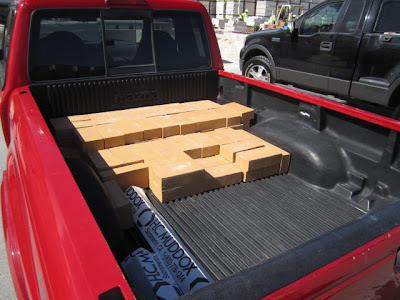In between laying on the insulation and then cementing over with a vermiculite cement mix, I did an initial firing of the oven with kiawe wood (aka mesquite wood). Kiawe wood grows on the arid places on the island. Historical note: It was initially brought over by catholic missionaries, and the first kiawe stump can be viewed at Our Lady of Peace at Fort Street Mall.
I bought $220 worth of kiawe wood cut up 18 inches long and around 3 inches in diameter. I found John off of Craigslist:
Okay, firing up the oven with the kiawe wood. If this is what it is going to take i.e. tons of smoke and soot all over the place, 2 1/2 hours or so to do, then horrors!!!
But fear not as one of my thinking way ahead ideas was to use PROPANE to provide heat to the oven. I searched online and settled on this cast iron burner from Teja's Smokers:
The great thing about this burner is that "ANY LENGTH" part. That is the pipe that connects the propane/air baffle mixer to the actual burner itself. In other words, the air and the propane is mixed OUTSIDE OF THE OVEN and then "piped in" to the burner that sits in the oven.
And that is exactly what I did:
Propane hookup and air mixing vane that's OUTSIDE the oven proper. And below is the burner at about 1/2 maximum:
This particular burner puts out 160,000 BTU per hour. That heat capacity is about the heat output from a medium wood fire. In heating up your oven, you don't want a hot hot blast of fire that will just use up all your wood (or propane in this case) for no good purpose; you want instead a steady heat source that will slowly heat up your oven's thermal mass.
And this HPGX-2 burner from Tejas Smokers does the job most excellently with NO smoke, No ash and No wood or wood babysitting!
Since this propane burner is cemented into the oven, it will be considered part of the oven building process, so one HPGX-2 burner from Tejas Smokers for $128.85 (including pressure regulator) delivered to me in Honolulu. I also got a 3/4 inch by 10 inch black pipe nipple from Home Depot for $3.42.
Hmmmm. Looking at the pile of kiawe wood (mesquite) I got for $220, that is the equivalent of 11 tanks (20 lbs. per) of propane refills from Home Depot. Having burned some kiawe wood already, I am quite positive that 11 propane tanks will outlast that $220 pile of kiawe wood I bought. So it is a win cost wise too (along with no ash, no smoke to bother my neighbors and no babysitting the wood burning!)












































